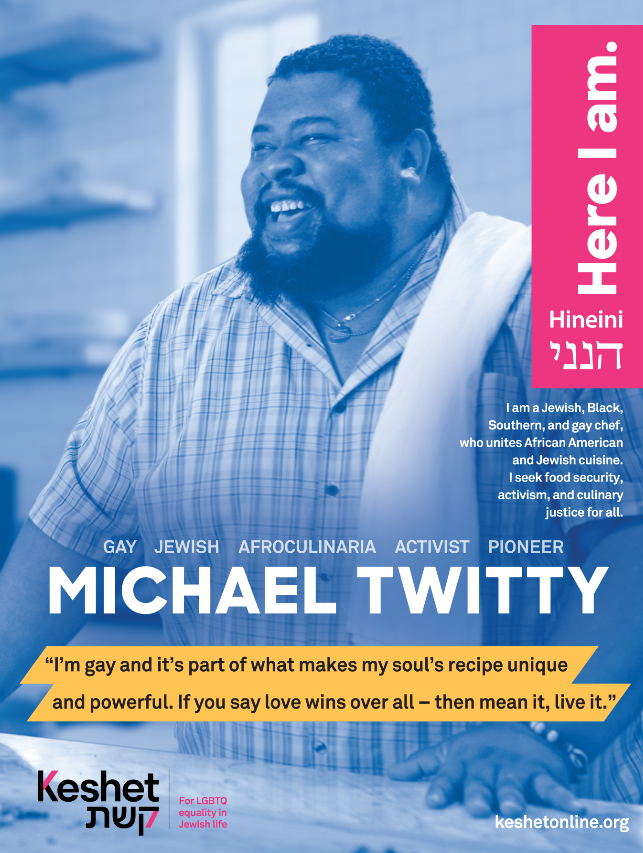 Introduction
Introduction
Time: 45 mins
Age: 12-18
Materials:
- Keshet’s LGBTQ Jewish Heroes posters
- technology to share a video with sound
- Large pieces of paper OR non-plasticized paper plates; markers
Goals:
- Students will learn about contemporary LGBTQ Jewish hero Michael Twitty
- Students will explore their own relationship to history via food
Considerations:
- This lesson heavily centers food, which is a challenging topic for some. Food can be a sensitive topic for people with a history of disordered eating or food insecurity. Be mindful that some students may need to take breaks or engage differently than expected in this lesson.
- This lesson raises questions about what is “Jewish food.” One of the goals of this lesson is to think expansively about what Jewish food is. The facilitator should be prepared to bring in representation of global foods and push students to think past “ashkenormative” frameworks. See appendix for further resources.
Frame (3 mins)
Today we will be learning about a contemporary Jewish hero. It’s important to learn about Jewish heroes because there are so many extraordinary Jews in our history and present who have made important contributions to the Jewish people and the world at large. It’s also important to learn about lots of different Jewish heroes because it uplifts the fact that the Jewish community is diverse, and there is no one way to be Jewish. Today we are going to learn about Michael Twitty.
Learn (3 mins)
(Read aloud or have a student read aloud)
“As a Jewish, Black, Southern, and gay chef and writer, Michael (he/him/his) brings something special to the table. The award-winning author of 2018’s The Cooking Gene: A Journey Through African-American Culinary History in the Old South, Michael also unites African American and Jewish cuisine and is a powerful voice for food security, activism, and culinary justice for all.”
Further resources about Michael Twitty provided in the appendix.
Watch (9 mins)
Watch this video featuring Michael Twitty as he explains the importance of understanding where our food comes from and the stories therein.
Engage – Option 1 (30 mins)
ages 15-18
Set up 5 large flipchart paper around the room. Write one of the following discussion prompts on each paper. (Or, write your own prompts!) For this activity, divide the class into 5 small groups and assign each group to a piece of paper. Give the groups 3-4 minutes to write their answers on the paper, and then have the entire class rotate to the next paper. At the end, make sure to have students share out all the answers to the whole class.
- Why is it so important to Michael to understand where dishes and recipes come from?
- What role does food play in your life and in your family?
- Do you know the stories or histories of the foods you enjoy at home? Which ones?
- Is there such a thing as “Jewish food?” If so, what is it and what makes it Jewish?
- How does being a diasporic people impact the foods Jews eat?
Engage – Option 2 (30 mins)
ages 12-14
Give each student a non-plasticized paper plate. Ask students to think about a meal or recipe that invokes a story or a history for them. On the front, have students draw a picture of the meal. On the back, instruct students to write the story or history of the meal. When they are done, have students pair share or share with the whole class.
Extras
if you have more time, multiple lessons, or want to assign homework
- After using the framing above, have students interview someone over the age of 60 about a family recipe. Make sure students ask the name of the recipe, where it came from, and any stories associated with it.
- For virtual groups: assign each student a different “Jewish food” to research and report back to the class. Make sure to include plenty of non-Ashkenazi dishes from around the globe! See appendix for further guidance and resources.
- Assign students to cook a special family recipe, and then have a potluck where students can showcase their dish and explain its significance to the class. This can be adapted for online learning as well. Students can take pictures of themselves making the meal, and then bring the dish to the online gathering where everyone can eat “together.” For younger students, make sure to have adult supervision/help with cooking involving knives or stoves/ovens.
- Michael Twitty uses food to explore and embrace his multiple identities. He often uplifts his race, sexuality, and religion. Lead a discussion (or pair share) for students to think about what identities they think about the most and why. This can dovetail nicely into a discussion of Jewish values of b’zelem elohim (created in G!d’s image) and kavod (respect) and why it is important to respect and celebrate everyone’s authentic selves.
Appendix
Further material about Michael Twitty:
Further resources on Jewish foods from around the world:

 Introduction
Introduction